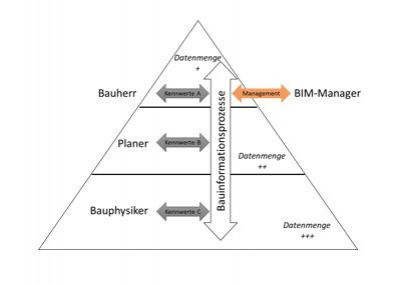

Ziel des Forschungsvorhabens ist die experimentelle Entwicklung des Softwaresystems VARIUS-Explorer. Das Tool arbeitet als Entscheidungsunterstützung für den Bauherrn, indem es Planungsvarianten mit genau den von ihm erwarteten Kennzahlen prägnant und mit einfacher Bedienung präsentiert. Dadurch können fundiertere Entscheidungen im Planungsprozess getroffen werden als durch die Vorlage von Plänen, Listen und Diagrammen (Überinformation). Varianten des Gebäudes (Geometrie, Material, Heiz- und Lüftungssystem, Nutzerverhalten usw.) können so auf Basis aktuellster Planungsmethoden im Zuge eines aktiven Decision Making quantitativ bewertet werden. Die vorgelegten Varianten werden von bauphysikalischen Simulationen getragen, welche einen entscheidenden Einfluss auf das Erreichen des Ziels - nachhaltig zu Bauen und energieeffizient zu Betreiben - haben. Der Mehrwert dieses erhöhten Planungsaufwandes wird Planern, BIM-Managern und Investoren über die Betrachtung von Lebenszyklus-Kennzahlen aufgezeigt. Durch die Entwicklung neuer Informations- und Kommunikationstechnologien für Energieeffizienz leistet das Vorhaben einen Beitrag in den beiden Forschungsfeldern Energie und Digitale Kommunikation der Innovationsstrategie des Freistaates Sachsen. Auf allen Ebenen - von der Simulation über die Planung bis zum Bauherrn - werden im VARIUS-Explorer konkrete Kennzahlen als gemeinsame Sprache aller am Bau Beteiligten genutzt. Bauphysiker liefern als Simulationsexperten bauphysikalische Kennwerte und energetische Betriebskosten, die Planer erstellen Planungskennwerte (bspw. zu Architektur, technischer Gebäudeausrüstung TGA, Errichtungskosten) und der Bauherr definiert entscheidungsrelevante Kennwerte zu Investition, Risiko und Betrieb. Das Softwaresystem ermöglicht dabei die Verdichtung der hohen Datenmenge auf den unteren Detaillierungsebenen (Fachexperten und Planer) immer weiter und nutzbringend bis hin zu Bauherren- und Investorenkennzahlen. Dabei kommen vorrangig offene Datenstandards und Schnittstellen zum Einsatz. Neu zu erstellende Datenformate werden nach Projektende buildingSMART Germany für eine mögliche Standardisierung übergeben. So soll das openBIM-Paradigma gestützt und KMUs eine chancengleiche Teilnahme an den neuen Bauinformationsprozessen ermöglicht werden. The aim of the research project is the experimental development of the software system VARIUS-Explorer. It provides planning scenarios with the parameters expected by the building-owner and therefore supports the process of decision-making by giving concise key figures in a very user-friendly way. As a result, more well-founded decisions can be made throughout the planning process in contrast to the presentation of plans, lists and diagrams which mostly lead to information overload. Therefore, variants of the building (geometry, material, heating and ventilation system, user behavior, etc.) can be quantitatively evaluated based on current planning methods as part of an active decision-making process. The presented variants are based on building physics simulations and they have a decisive influence on goals like sustainable constructions and energy-efficient operated buildings. The benefit of this additional planning effort will be shown to planners, BIM managers and investors by looking at the life cycle indicators. By developing new information and communication technologies for energy efficiency, the project contributes to the research fields of energy and digital communication of the innovation strategy of the Free State of Saxony. At all levels, from the simulation via planning and up to the building owners, the VARIUS Explorer uses concrete key figures as common language of all parties that are involved in the construction. Building physicists as simulation experts provide building physics parameters and energy operating costs. Planners generate planning parameters (e.g. on architecture, building services, construction costs) and the building owner defines decision-relevant parameters for investment, risk and operation of the building. The software system allows to compress the high volume of data on lower levels of detail (specialized experts and planners) and simplifies it to parameters that are usable for clients or investors. For this purpose, open data standards and interfaces are used. New data formats which are required to be created will be commited to buildingSMART Germany for possible standardization after the end of the project. The aim is to support the openBIM paradigm and enable SMEs to equally participate in the new building information processes.
Arbeitsschritte im Projekt VARIUS / Software-Entwicklung : AP 1 Kennwerte-Manager (Softwaresystem und Services zur Verwaltung, Vorgabe, Strukturierung, Belegung und zum Datenaustausch von Kennwerten - Kennwerte-Modell: Schema für Kennwerte und deren Verknüpfungsregeln; Stammdatenbank für Kennwerte und Regeln im Bereich Energieeffizienz; Schnittstelle energyPlus / NANDRAD Kennwerte-Modell; Schnittstelle BIM-LV-Container /DIN SPEC 91350/ Kennwerte-Modell; VARIUS-Explorer Kennwerte-Manager Software-System). AP 2 Varianten-Manager (Softwaresystem und Services zur Zusammenstellung, Verwaltung, Prüfung und zum Datenaustausch von Planungsvarianten basierend auf Multimodellen - Verlinkung von Kennwerte-Modell mit IFC-Daten; Variantenmodell: Schema zur Komposition multimodellbasierter Varianten; VARIUS-Explorer Varianten-Manager Software-Applikation). AP 3 VARIUS-Explorer (Software und Services zur einfachen Erschließung und Visualisierung von Planungsvarianten - Schemaimport Kennwerte-Modell; GUI zur Kennwertevisualisierung; dynamische GUI zur Variantenbedienung freier Parameter - Software-Kalibrierung und Pilot-Planungsprojekt). AP 4 Variantenbasierter Gebäudeentwurf (BIM-basierter Gebäudeentwurf mit Variantenuntersuchung unter Einsatz der neuen Software-Tools und Bauinformationsprozesse - Planungsbegleitendes Kennwerte-Management; Objektplanung mit Varianten; bauphysikalische Simulation; Variantenauswertung und Entscheidungsprozesse). AP 5 Kalibrierung des Softwaresystems (Rückfluss der praktischen Erkenntnisse aus AP 4 und Verbesserung von Software und Modellen - Validierung des KP-Modells; iterative Nutzerevaluierung und Softwareanpassung; abschließender Testlauf und Demonstrator).